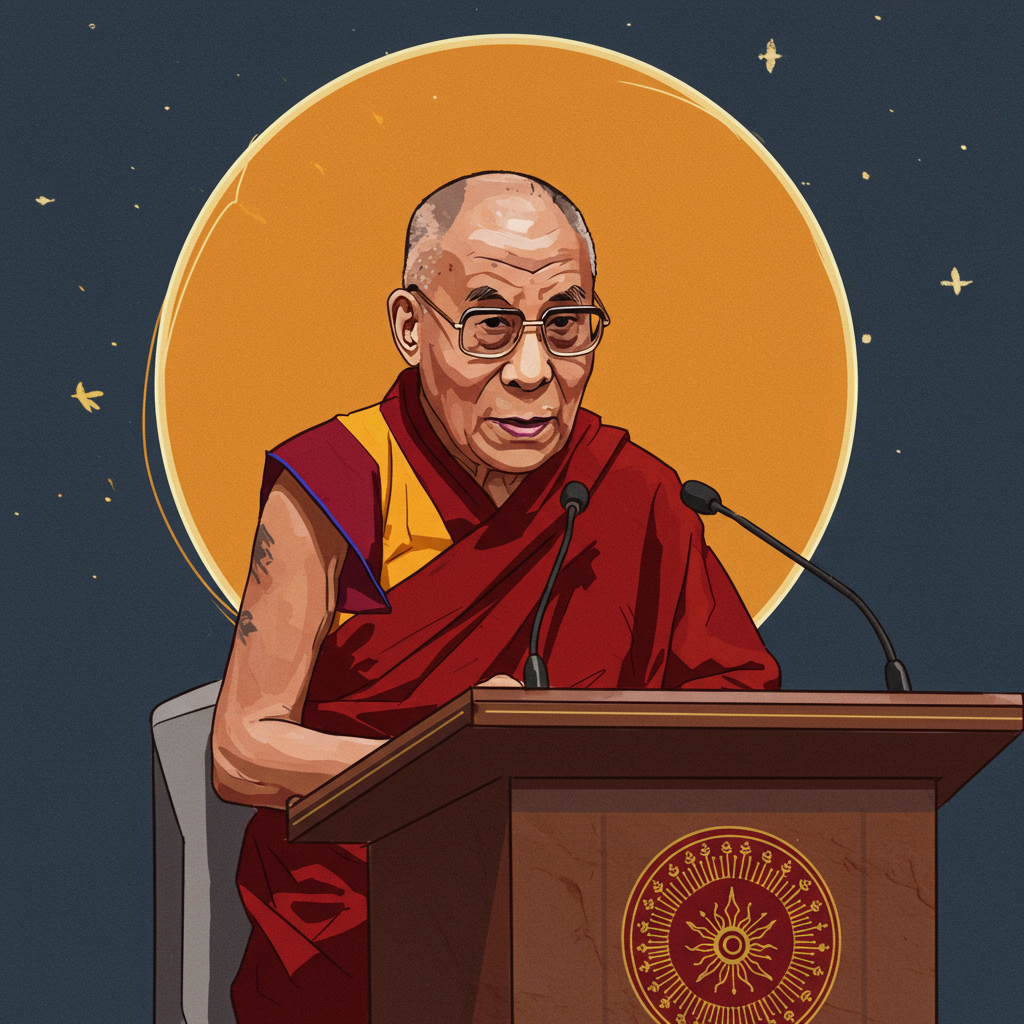In a pivotal declaration just days before his 90th birthday, the exiled tibetan spiritual leader, the dalai Lama, has definitively affirmed the continuation of his lineage and outlined a clear process for identifying his reincarnation. This long-awaited statement aims to quell speculation and, crucially, directly challenges china‘s persistent claim over the right to choose the next leader of Tibetan Buddhism. Made during a week of celebrations in Dharamshala, India, where he lives in exile, the announcement sets the stage for a renewed international confrontation over the future of Tibet and its spiritual heritage.
For centuries, the Dalai Lama has been not only a religious figure but also a powerful symbol of Tibetan identity and resistance to Chinese rule. His decision to ensure the institution continues is seen as a significant moment for millions of his followers worldwide. It puts to rest previous considerations he had raised about potentially being the last Dalai Lama. Instead, he has provided a roadmap, placing the crucial responsibility for succession squarely within Tibetan Buddhist tradition and outside Beijing’s influence.
The Dalai Lama’s Definitive Succession Plan
The 14th Dalai Lama, Tenzin Gyatso, born Lhamo Dhondup in 1935, clarified that upon his death, he will be reincarnated. This core tenet of Tibetan Buddhism, where the soul of a senior monk is believed to pass into the body of a child, remains central to the process. However, the crucial update lies in who holds the authority to recognize this reincarnation.
He explicitly stated that the Gaden Phodrang Trust, a non-profit organization he established in India, possesses the sole authority for this vital task. This Trust, dedicated to maintaining and supporting the tradition and institution of the Dalai Lama, will consult with the heads of Tibetan Buddhist traditions to carry out the search and recognition procedures. “No one else has any such authority to interfere in this matter,” the Dalai Lama asserted in a video message. This firm statement is a direct response to Beijing’s insistence on controlling the process.
The Dalai Lama’s announcement was met with relief and happiness by Tibetan followers gathered in Dharamshala. Many see it as validating their belief in the continuation of the lineage and directly countering China’s narrative. Tibetan Buddhist leaders at the 15th Tibetan Religious Conference unanimously supported the Dalai Lama’s plan, condemning what they called China’s “usage of reincarnation subject for their political gain.”
China’s Counterclaim: A Historical Conflict
China annexed Tibet in the 1950s, leading to the Dalai Lama’s flight to India in 1959 after a failed uprising. Beijing views him as a dangerous separatist and has long sought to control the succession process as a means of solidifying its authority over Tibet. Chinese officials reiterated their stance immediately following the Dalai Lama’s statement.
Beijing maintains that the Dalai Lama’s reincarnation must be approved by the central government in China. They claim this right is based on historical precedent, particularly a ritual dating back to the Qing dynasty in 1793. This ritual, involving drawing names of potential reincarnations from a “golden urn,” is cited by China’s foreign ministry spokesperson, Mao Ning, as the legitimate method. Mao Ning stated that the child reincarnation of a major Living Buddha like the Dalai Lama requires identification through this method and approval by the central government.
Critics, however, argue that China’s claim is purely political. They point out that while the “golden urn” was used historically in some cases, the 14th Dalai Lama’s identification did not involve it. Beijing’s insistence is seen as a cynical attempt to install a state-approved figure who would be loyal to the Communist Party, rather than a spiritual leader recognized by Tibetan tradition and practitioners.
The Battle for Spiritual Authority
The conflict over the Dalai Lama’s successor is not new, nor is it abstract. A stark precedent exists with the Panchen Lama, the second-highest figure in Tibetan Buddhism. In 1995, the Dalai Lama recognized a six-year-old boy, Gedhun Choekyi Nima, as the reincarnation of the Panchen Lama. Shortly thereafter, the boy disappeared and is widely believed to have been held captive by Chinese authorities for 30 years. Beijing appointed its own candidate, who lacks legitimacy among the majority of Tibetans. This history fuels deep anxiety that China plans to repeat this tactic with the Dalai Lama’s succession.
The Dalai Lama has previously stated that his successor would likely be born outside China and has urged his followers to reject any candidate chosen by Beijing for political ends. Penpa Tsering, leader of the Central Tibetan Administration (the Tibetan government-in-exile), echoed this, quoting the Dalai Lama as saying he would be born in a “free world,” linking this to his view on visiting Tibet where he feels there is “no freedom.”
Samdhong Rinpoche, a senior official of the Gaden Phodrang Trust, added further details. He stated that the Dalai Lama, currently in good health, has not yet provided written instructions on succession. Crucially, Rinpoche clarified that the potential successor could be of any gender and their nationality would not be restricted to Tibet. This opens the door for a successor born outside of Tibet, potentially in India or elsewhere in the Tibetan diaspora, or even a female Dalai Lama.
Global Attention and Implications
The Dalai Lama’s succession is a matter watched closely by governments worldwide. The United States, which faces rising competition from China, has repeatedly voiced commitment to advancing the human rights of Tibetans. US lawmakers have indicated they would not tolerate Chinese interference in the choice of the Dalai Lama’s successor.
India, as the host country for the Dalai Lama and over 100,000 Tibetan refugees since 1959, navigates a delicate diplomatic balance with China. However, India has generally supported the Dalai Lama’s right to pursue spiritual activities. A recent declaration signed by Indian MPs affirmed the Dalai Lama’s exclusive right to choose his successor, a notable stance against Beijing’s claims.
Penpa Tsering also mentioned that the Tibetan government-in-exile is seeking alternative funding sources, noting that the US has lifted some restrictions on funds for Tibetans in exile. This indicates ongoing international support for the Tibetan cause, distinct from Beijing’s influence.
The Dalai Lama’s statement clarifies the path forward according to Tibetan religious tradition, directly confronting China’s attempts to control the process for political gain. Experts like Robert Barnett view the statement as a clear rebuke to China, signalling that the Dalai Lama will decide his own reincarnation based on popular consent, challenging Beijing’s reliance on force for legitimacy in Tibet. The future could potentially see two rival Dalai Lamas – one chosen through traditional means by the Trust and one appointed by Beijing – forcing followers and the global community to choose which to recognize.
Frequently Asked Questions
What is the Gaden Phodrang Trust and its role in the Dalai Lama’s succession?
The Gaden Phodrang Trust is a non-profit organization established by the Dalai Lama in India. Its purpose is to maintain and support the traditions and institution of the Dalai Lama. According to the Dalai Lama’s recent statement, this Trust holds the sole authority to identify his future reincarnation after his death. The Trust members will consult with heads of Tibetan Buddhist traditions and reliable protectors to conduct the search and recognition process according to past traditions, explicitly excluding interference from others, particularly China.
Why does China claim the right to choose the Dalai Lama’s successor?
China claims the right to approve the Dalai Lama’s reincarnation based on historical precedent dating back to the Qing dynasty (1793). Beijing argues that the process must adhere to Chinese laws and regulations, often citing the use of a “golden urn” ritual for selecting major Living Buddhas. Critics view this claim as a political maneuver by the Chinese government to control Tibetan Buddhism and its leadership, aiming to install a successor loyal to the Communist Party rather than one recognized through traditional spiritual means by Tibetan Buddhists.
Can the next Dalai Lama be female or born outside of Tibet?
Yes, according to Samdhong Rinpoche, a senior official of the Gaden Phodrang Trust, the potential successor to the Dalai Lama could be of any gender. Additionally, their nationality would not be restricted to Tibet. This means the next Dalai Lama could potentially be born outside of the Tibetan Autonomous Region, possibly among the Tibetan diaspora in India or elsewhere, or even be a woman, broadening the potential pool based on traditional signs rather than geographical or gender constraints.
Conclusion
The Dalai Lama’s recent statement on his reincarnation and succession is a powerful assertion of Tibetan spiritual authority against the backdrop of ongoing political conflict with China. By vesting the sole authority for identifying his successor in the India-based Gaden Phodrang Trust, the Dalai Lama has sought to ensure the continuation of his lineage according to traditional practices, free from state control. While China maintains its historical claim and intention to appoint its own successor, the Dalai Lama has urged his followers to reject any politically motivated choice by Beijing. This fundamental disagreement sets the stage for a complex and contentious future, where the world may face the unprecedented situation of rival claimants to the spiritual leadership of Tibetan Buddhism, highlighting the deep cultural and political divide surrounding Tibet. The Dalai Lama’s message underscores the resilience of Tibetan identity and faith in the face of prolonged exile and political pressure.




